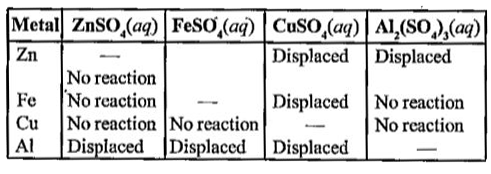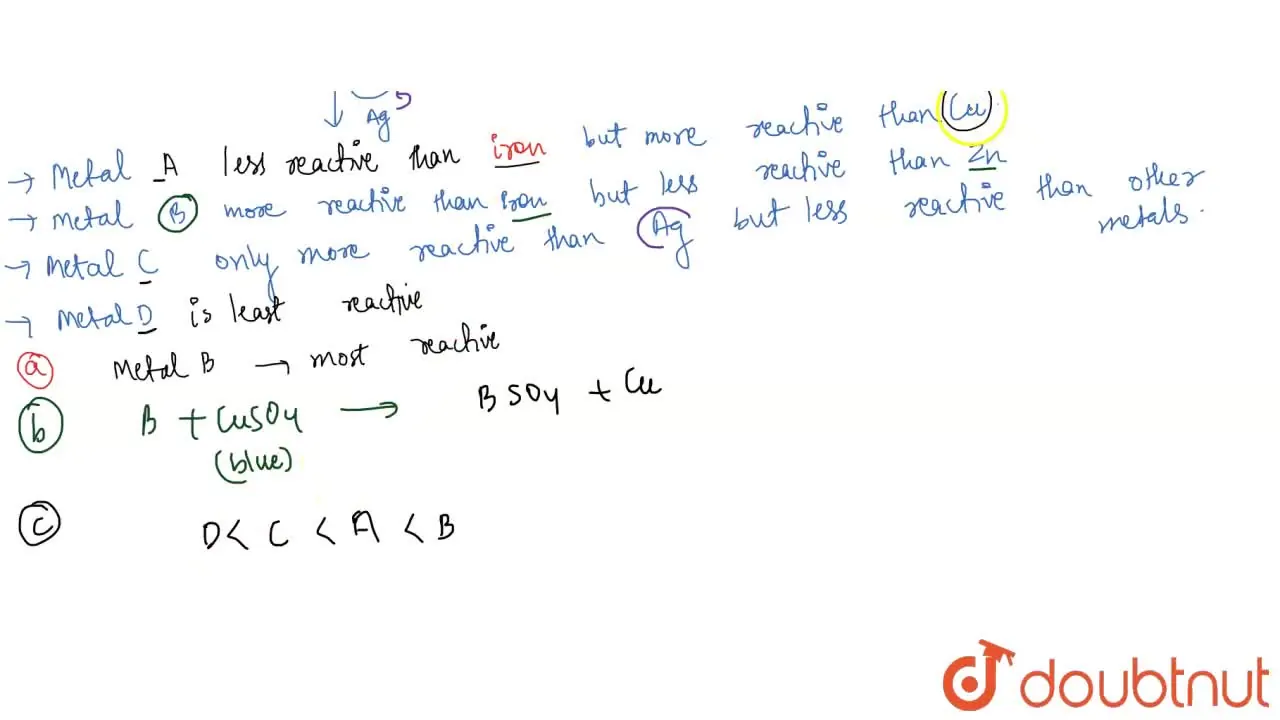Samples of four metals A, B, C and D were taken and were added to the following solutions one by one.
The results obtained have been tabulated as follows :
MetalSolution to which metal is addedIron(II) sulphateCopper(II) sulphateZince sulphateSilver nitrateANo reactionDisplacement __ __BDisplacement __No reaction __CNo reactionNo reactionNo reactionDisplacementDNo reactionNo reactionNo reactionNo reaction
Use the table given above to answer the following questions :
(a) Which is the most reactive metal ?
(b) What would you observe when B is added to solution of copper(II) sulphate ?
(c ) Arrange the metals A, B, C and D in order of increasing reactivity.
Based on the activity series, the relative position of the metals in which involved in solution is :
Zn>Fe>Cu>Ag. On the basis of the results given in the table.
• Metal A is more reactive than copper and less reactive then iron.
• Metal B is more reactive than iron and less reactive than zinc.
• Metal C is only more reactive than silver and less reactive than other metals.
• Metal D is equally or less reactive than silver.
In the light of above information, we can conclude that
(a) Metal B is the most reactive.
(b) Since B is more reactive than iron, it is also more reactive than copper. This means that it would displace copper from copper(II) sulphate solution. The blue colour of solution will slowly fade.
(c ) The decreasing order of reactivity of metals is : B>A>C>D.
Related Playlists
- BOOK - DINESH PUBLICATIONCHAPTER - METALS AND NON-METALSEXERCISE - Very Short Answer Questions67videos
METALS AND NON-METALS
- BOOK - DINESH PUBLICATIONCHAPTER - METALS AND NON-METALSEXERCISE - Short Answer Questions45videos
METALS AND NON-METALS
- BOOK - DINESH PUBLICATIONCHAPTER - METALS AND NON-METALSEXERCISE - MCQ64videos
METALS AND NON-METALS
- BOOK - DINESH PUBLICATIONCHAPTER - CHEMICAL REACTIONS AND EQUATIONS EXERCISE - Multiple Choice Questions18videos
CHEMICAL REACTIONS AND EQUATIONS
- BOOK - DINESH PUBLICATIONCHAPTER - PERIODIC CLASSIFICATION OF ELEMENTSEXERCISE - PBQs28videos
PERIODIC CLASSIFICATION OF ELEMENTS
Similar Questions
The table given below, in which samples of four metals P, Q, R and S were taken and added to the following solutions one by one . The result obtained have been tabulated as follows

Which is the least reactive metal ?View SolutionThe table given below, in which samples of four metals P, Q, R and S were taken and added to the following solutions one by one . The result obtained have been tabulated as follows

Which is the most reactive metal ?View SolutionThe table given below, in which samples of four metals P, Q, R and S were taken and added to the following solutions one by one . The result obtained have been tabulated as follows

What would observe if Q is added to a solution of copper (II) sulphate ?View SolutionSamples of four metals A, B, C and D were taken and were added to the following solutions one by one.
The results obtained have been tabulated as follows :
MetalSolution to which metal is addedIron(II) sulphateCopper(II) sulphateZince sulphateSilver nitrateANo reactionDisplacement __ __BDisplacement __No reaction __CNo reactionNo reactionNo reactionDisplacementDNo reactionNo reactionNo reactionNo reaction
Use the table given above to answer the following questions :
(a) Which is the most reactive metal ?
(b) What would you observe when B is added to solution of copper(II) sulphate ?
(c ) Arrange the metals A, B, C and D in order of increasing reactivity.View Solution__ is displaced when zinc is added to the solution of copper sulphate ..
View SolutionFour metals Zn, Fe, Cu and Al are taken and added to the following solutions one by one. The results obtained are tabulated below:

From the above data, the decreasing order of-reac- tivity of metals isView SolutionSamples of four metals A, B, C and D were taken and added to the following solution one by one. The results obtained have been tabulated as follows:

Use the Table given above to answer the following questions about metals A, B, C and D:
(i) Which is the most reactive metal ? (ii) What would you observe if B is added to a solution of Copper(II) sulphate ? (iii) Arrange the metals A, B, C and D in the order of decreasing reactivity.View SolutionSamples of four metals A , B ,C and D were taken and added to the following solution one by one. The results obtained have been tabulated as follows:

Use the table above to answer the following question about metals A,B ,C and D.
(i) Which is the most reactive metal?
(ii) What would you observe, if B is added to a solution of copper(II) sulphate?
(iii) Arrange the metals A,B,C and D in the order of decreasing reactivity.View SolutionRead the following ans answer any four metals A,B,C and D added following solutions one. The results obtained have tabulated as follows :

Choose the most reactive metal:View SolutionSamples of four metals A, B, C and D were taken and added to the following solution one by one. The results obtained have been tabulated as follows.
Use the Table above to answer the following questions about metals A, B, C and D.
(i) Which is the most reactive metal?
(ii) What would you observe if B is added to a solution of Copper (II) sulphate?
(iii) Arrange the metals A, B, C and D in the order of decreasing reactivity.View Solution



